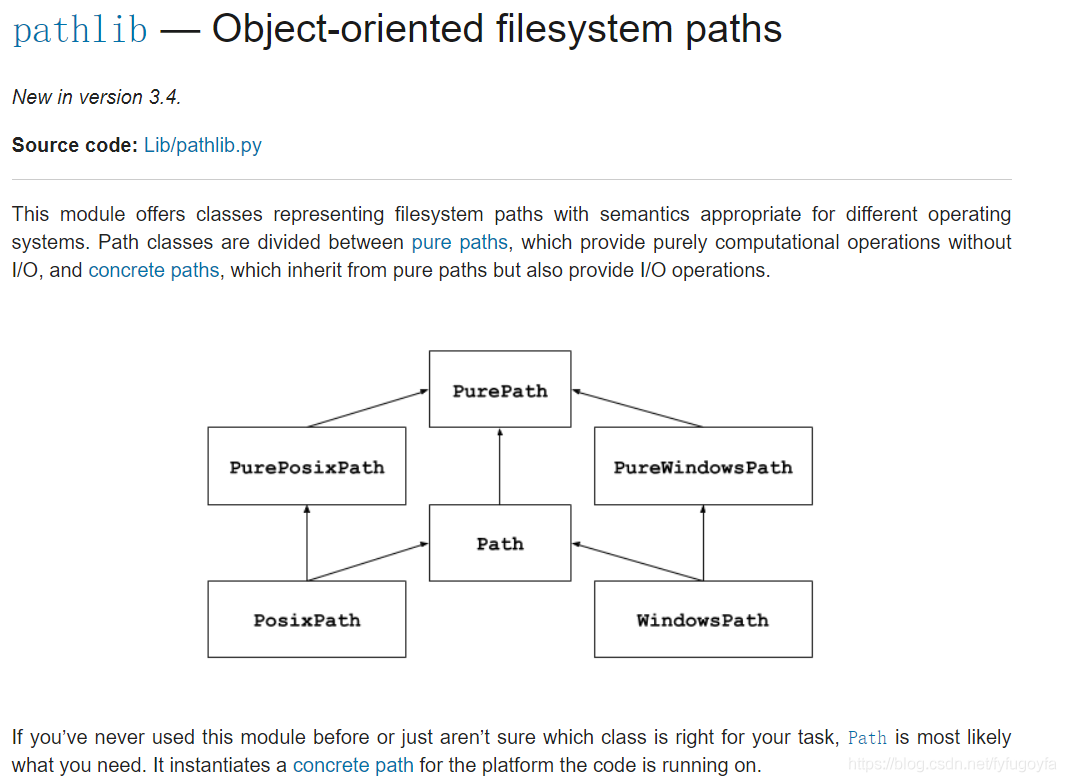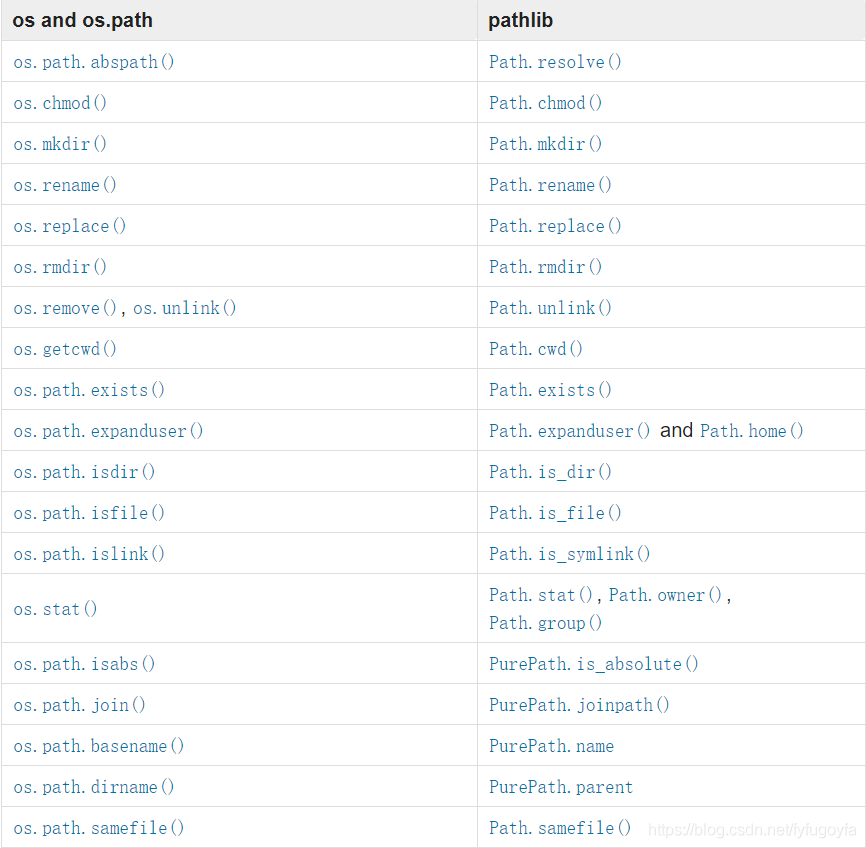前言
相比常用的 os.path而言,pathlib 對于目錄路徑的操作更簡介也更貼近 Pythonic。但是它不單純是為了簡化操作,還有更大的用途。
pathlib 是Python內置庫,Python 文檔給它的定義是:The pathlib module – object-oriented filesystem paths(面向對象的文件系統路徑)。pathlib 提供表示文件系統路徑的類,其語義適用于不同的操作系統。

更多詳細的內容可以參考官方文檔:https://docs.python.org/3/library/pathlib.html#methods
1. pathlib模塊下Path類的基本使用
|
1
2
3
4
5
6
7
8
9
10
11
12
13
|
from pathlib import Pathp = Path(path)print(p.name) # 獲取文件名print(p.stem) # 獲取文件名除后綴的部分print(p.suffix) # 獲取文件后綴print(p.parent) # 相當于dirnameprint(p.parent.parent.parent)print(p.parents) # 返回一個iterable 包含所有父目錄for i in p.parents: print(i)print(p.parts) # 將路徑通過分隔符分割成一個元組 |
運行結果如下:
pathlib模塊的基本使用.py
pathlib模塊的基本使用
.py
D:\python\pycharm2020\program
D:\python
<WindowsPath.parents>
D:\python\pycharm2020\program
D:\python\pycharm2020
D:\python
D:\
('D:\\', 'python', 'pycharm2020', 'program', 'pathlib模塊的基本使用.py')
- Path.cwd():Return a new path object representing the current directory
- Path.home():Return a new path object representing the user's home directory
- Path.expanduser():Return a new path with expanded ~ and ~user constructs
|
1
2
3
4
5
6
7
8
|
from pathlib import Pathpath_1 = Path.cwd() # 獲取當前文件路徑path_2 = Path.home()p1 = Path('~/pathlib模塊的基本使用.py')print(path_1)print(path_2)print(p1.expanduser()) |
運行結果如下:
D:\python\pycharm2020\program
C:\Users\Administrator
C:\Users\Administrator\pathlib模塊的基本使用.py
Path.stat():Return a os.stat_result object containing information about this path
|
1
2
3
4
5
6
7
8
9
10
11
12
|
from pathlib import Pathimport datetimep = Path('pathlib模塊的基本使用.py')print(p.stat()) # 獲取文件詳細信息print(p.stat().st_size) # 文件的字節大小print(p.stat().st_ctime) # 文件創建時間print(p.stat().st_mtime) # 上次修改文件的時間creat_time = datetime.datetime.fromtimestamp(p.stat().st_ctime)st_mtime = datetime.datetime.fromtimestamp(p.stat().st_mtime)print(f'該文件創建時間:{creat_time}')print(f'上次修改該文件的時間:{st_mtime}') |
運行結果如下:
os.stat_result(st_mode=33206, st_ino=3659174698076635, st_dev=3730828260, st_nlink=1, st_uid=0, st_gid=0, st_size=543, st_atime=1597366826, st_mtime=1597366826, st_ctime=1597320585)
543
1597320585.7657475
1597366826.9711637
該文件創建時間:2020-08-13 20:09:45.765748
上次修改該文件的時間:2020-08-14 09:00:26.971164
從不同.stat().st_屬性 返回的時間戳表示自1970年1月1日以來的秒數,可以用datetime.fromtimestamp將時間戳轉換為有用的時間格式。
Path.exists():Whether the path points to an existing file or directory
Path.resolve(strict=False):Make the path absolute,resolving any symlinks. A new path object is returned
|
1
2
3
4
5
6
7
8
9
10
11
12
|
from pathlib import Pathp1 = Path('pathlib模塊的基本使用.py') # 文件p2 = Path(r'D:\python\pycharm2020\program') # 文件夾 absolute_path = p1.resolve()print(absolute_path)print(Path('.').exists())print(p1.exists(), p2.exists())print(p1.is_file(), p2.is_file())print(p1.is_dir(), p2.is_dir())print(Path('/python').exists())print(Path('non_existent_file').exists()) |
運行結果如下:
D:\python\pycharm2020\program\pathlib模塊的基本使用.py
True
True True
True False
False True
True
False
Path.iterdir():When the path points to a directory,yield path objects of the directory contents
|
1
2
3
4
5
|
from pathlib import Pathp = Path('/python')for child in p.iterdir(): print(child) |
運行結果如下:
\python\Anaconda
\python\EVCapture
\python\Evernote_6.21.3.2048.exe
\python\Notepad++
\python\pycharm-community-2020.1.3.exe
\python\pycharm2020
\python\pyecharts-assets-master
\python\pyecharts-gallery-master
\python\Sublime text 3
Path.glob(pattern):Glob the given relative pattern in the directory represented by this path, yielding all matching files (of any kind),The “**” pattern means “this directory and all subdirectories, recursively”. In other words, it enables recursive globbing.
Note:Using the “**” pattern in large directory trees may consume an inordinate amount of time
遞歸遍歷該目錄下所有文件,獲取所有符合pattern的文件,返回一個generator。
獲取該文件目錄下所有.py文件
|
1
2
3
4
5
6
7
8
|
from pathlib import Pathpath = r'D:\python\pycharm2020\program'p = Path(path)file_name = p.glob('**/*.py')print(type(file_name)) # <class 'generator'>for i in file_name: print(i) |
獲取該文件目錄下所有.jpg圖片
|
1
2
3
4
5
6
7
8
|
from pathlib import Pathpath = r'D:\python\pycharm2020\program'p = Path(path)file_name = p.glob('**/*.jpg')print(type(file_name)) # <class 'generator'>for i in file_name: print(i) |
獲取給定目錄下所有.txt文件、.jpg圖片和.py文件
|
1
2
3
4
5
6
7
8
9
10
11
12
13
14
15
|
from pathlib import Pathdef get_files(patterns, path): all_files = [] p = Path(path) for item in patterns: file_name = p.rglob(f'**/*{item}') all_files.extend(file_name) return all_filespath = input('>>>請輸入文件路徑:')results = get_files(['.txt', '.jpg', '.py'], path)print(results)for file in results: print(file) |
Path.mkdir(mode=0o777, parents=False, exist_ok=False)
- Create a new directory at this given path. If mode is given, it is combined with the process' umask value to determine the file mode and access flags. If the path already exists, FileExistsError is raised.
- If parents is true, any missing parents of this path are created as needed; they are created with the default permissions without taking mode into account (mimicking the POSIX mkdir -p command).
- If parents is false (the default), a missing parent raises FileNotFoundError.
- If exist_ok is false (the default), FileExistsError is raised if the target directory already exists.
- If exist_ok is true, FileExistsError exceptions will be ignored (same behavior as the POSIX mkdir -p command), but only if the last path component is not an existing non-directory file.
Changed in version 3.5: The exist_ok parameter was added.
Path.rmdir():Remove this directory. The directory must be empty.
|
1
2
3
4
5
|
from pathlib import Pathp = Path(r'D:\python\pycharm2020\program\test')p.mkdir()p.rmdir() |
|
1
2
3
4
5
|
from pathlib import Pathp = Path(r'D:\python\test1\test2\test3')p.mkdir(parents=True) # If parents is true, any missing parents of this path are created as neededp.rmdir() # 刪除的是test3文件夾 |
|
1
2
3
4
|
from pathlib import Pathp = Path(r'D:\python\test1\test2\test3')p.mkdir(exist_ok=True) |
- Path.unlink(missing_ok=False):Remove this file or symbolic link. If the path points to a directory, use Path.rmdir() instead. If missing_ok is false (the default), FileNotFoundError is raised if the path does not exist. If missing_ok is true, FileNotFoundError exceptions will be ignored. Changed in version 3.8:The missing_ok parameter was added.
- Path.rename(target):Rename this file or directory to the given target, and return a new Path instance pointing to target. On Unix, if target exists and is a file, it will be replaced silently if the user has permission. target can be either a string or another path object.
- Path.open(mode=‘r', buffering=-1, encoding=None, errors=None, newline=None):Open the file pointed to by the path, like the built-in open() function does.
|
1
2
3
4
5
6
7
8
9
|
from pathlib import Pathp = Path('foo.txt')p.open(mode='w').write('some text')target = Path('new_foo.txt')p.rename(target)content = target.open(mode='r').read()print(content)target.unlink() |
2. 與os模塊用法的對比

總結
到此這篇關于python中pathlib模塊的基本用法與總結的文章就介紹到這了,更多相關python pathlib模塊用法內容請搜索服務器之家以前的文章或繼續瀏覽下面的相關文章希望大家以后多多支持服務器之家!
原文鏈接:https://blog.csdn.net/fyfugoyfa/article/details/107991203










